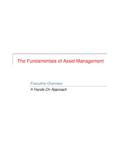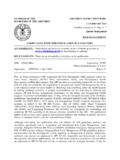Transcription of The Fundamentals of Asset Management - US EPA
1 The Fundamentals of Asset Management Step 6. Determine Business Risk ( Criticality ) A Hands-On Approach Fundamentals of Asset Management 2 Tom s bad Fundamentals of Asset Management 3 Third of 5 core questions assets are critical to sustained performance? How does it fail? How can it fail? What is the likelihood of failure? What does it cost to repair? What are the consequences of failure? Fundamentals of Asset Management 4 FMECA; Business Risk Exp.; Delphi Techniques AM plan 10-step process 3. Which assets are critical to sustain performance? Develop Asset Registry Assess Performance, Failure Modes Determine Residual Life Determine Life Cycle & Replacement Costs Set Target Levels of Service (LOS) Determine Business Risk ( Criticality ) Optimize O&M Investment Optimize Capital Investment Determine Funding Strategy Build AM Plan Fundamentals of Asset Management 5 Asset Management Risk is the heart of AM Risk Fundamentals of Asset Management 6 Definition of risk Risk in AM-speak is the consequence of failure multiplied by the probability of failure Often used as a measure of criticality Preferred term is business risk exposure (BRE) Fundamentals of Asset Management 7 Variables in business risk exposure Probability or likelihood of failure (PoF) Consequence or impact of failure (CoF)
2 Risk mitigation or risk reduction and avoidance Fundamentals of Asset Management 8 Let s clarify terms Ambiguous: Risk Criticality Preferred: Probability of failure Consequence of failure Business risk exposure Fundamentals of Asset Management 9 All assets have a probability of failure Two key the failure reasonably predictable? it cost-effectively preventable? Fundamentals of Asset Management 10 Most common patterns of failures Two key failure patterns curve typically applicable for mechanical and electrical assets Increasing Time Percent of Failures High Low Decreasing Fundamentals of Asset Management 11 Most common patterns of failures Two key failure patterns curve typically applicable for mechanical and electrical assets curve typically applicable for civil passive assets Increasing Time Percent of Failures High Low Decreasing Reliability the probability that a component or system will perform its specified function for the specified period under specified operation conditions Fundamentals of Asset Management 12 Recall the four major failure modes Failure Mode Definition Tactical Aspects Management Strategy Capacity Volume of demand exceeds design capacity Growth.
3 System expansion Redesign LOS Functional requirements exceed design capacity Codes & permits: NPDES, CSOs, OSHA, noise, odor, life safety; service, etc. O&M optimization, renewal Mortality Consumption of Asset reduces performance below acceptable level Physical deterioration due to age, usage (including operator error), acts of nature O&M optimization, renewal Efficiency Operations costs exceed that of feasible alternatives Pay-back period Replace NPDES is National Pollutant Discharge Elimination System, CSOs are combined sewer overflows, and OSHA is Occupational Safety and Health Administration Fundamentals of Asset Management 13 The role of primary failure modes in determining the probability of failure Yes Yes Yes No No No No Yes Yes Yes Yes Yes Capacity LOS Mortality Efficiency Start Redo it has to fail somehow Failure Mode Decision Issues End of Asset life 10 years 3 years 18 months 5 years Is capacity an issue?
4 Likely before other modes? Likely before other modes? Likely before other modes? Likely before other modes? Has LOS changed from design? Is physical reliability an issue? Is cost to operate an issue? probability of failure is different for each primary failure mode! for imminent primary failure mode! Range Fundamentals of Asset Management 14 Failure analysis Failure Cause Contributing & root causes; reasons why failure occurred Failure Behavior Evident, hidden, random, P-F interval Function Defined by performance standards Functional Failure End state or potential end state; Evidence what you see Failure Mode Mechanism of failure Failure Consequences Cost, safety, environmental Function (It works) Functional Failure (It doesn t work) Performance parameters What to monitor Failure end state Failure consequences Failure cause Failure behavior Failure mode Fundamentals of Asset Management 15 Cause and effect diagram Internal contact Water inside motor Burned out contactor Effect-Cause Electric motor burned out Effect Worn bearing Forklift bashed motor Physical damage Incorrectly assembled No lubrication No schedule No protective crash barrier No assembly procedure Root Cause Effect Cause Effect Cause Effect Cause Fundamentals of Asset Management 16 Probability of failure (PoF)
5 PoF is directly related to the failure mode We cannot absolutely determine PoF Sometimes we have good data, sometimes we do not We can estimate a range of failure how early (pessimistic) and how late (optimistic) Fundamentals of Asset Management 17 What are sources of Probability of Failure? CMMS mean time between failures (MTBF) Vendor and industry information Other failure records (hard copies) Our brilliant memories (staff) Our SCADA system (if we have one and if it keeps records on this Asset ) PoF is probability of failure, CMMS is computerized maintenance Management system, SCADA is supervisory control and data acquisition Fundamentals of Asset Management 18 Decay curve Mean Asset condition 100 Finding a proxy for measuring failure Can age, usage, or condition be substituted?.. Percent of Effective Life Consumed Performance Minimal Asset standard 50 Data distribution of Asset performance Low High 0 Assets performing below standard Age?
6 Usage? Condition? Fundamentals of Asset Management 19 Linking probability of failure to age of Asset ( % effective life consumed ) PoF is probability of failure % of Effective Life Consumed PoF Rating <10 1 20 2 30 3 40 4 50 5 60 6 70 7 80 8 90 9 Failed 10 Fundamentals of Asset Management 20 Linking probability of failure to direct observation tables Assessment * Probability Weighting Description Almost certain 100 Expected to occur within a year Very high 75 Likely to occur within a year High 50 Estimated 50% chance of occurring in any year Quite likely 20 Expected to occur within 5 years Estimated 20% chance of occurring in any year Moderate 10 Expected to occur within 10 years Estimated 10% chance of occurring in any year Low 2 Expected to occur within 50 years Very low 1 Expected to occur within 100 years * Likelihood of occurrence within a year Fundamentals of Asset Management 21 Recall alternative: tying condition score to Asset failure how?
7 Decay or failure curve 100 Percent of Effective Life Consumed Performance Physical Failure 60 Data distribution of Asset condition Poor Excellent 0 20 80 Condition 2 6 Minimum 10 8 4 1 40 Relating condition to Probability of Failure through % Physical Life Consumed Fundamentals of Asset Management 22 ElementSCORE1357910 Technical PerformanceSubstantially exceeds current requirementsExceeds current requirementsMeets current requirements but with room for improvementObvious concerns: cost/benefit questionsInefficient; becoming ineffective, obsoleteFailing, not capable of sustaining required performanceOperational PerformanceNegligible attention requiredExceeds current requirementsMeets current requirements but with room for improvementObvious concerns: cost/benefit questionsDifficult to sustain performanceFailing, not capable of sustaining required performanceReliabilityAs specified by manufacturerInfrequent breakdownOccasional breakdownPeriodic breakdownContinuous recurrent breakdownVirtually inoperableAvailabilityVirtually always operationalOut of service only for very short periodsOut of service for moderate period; moderately difficult to return to serviceIncreasingly difficult to return to service; parts becoming a challengeExtensive downtime duration; difficult to return to service.
8 Parts, difficult to acquire, rare skills requiredVirtually impossible to return to service; parts no longer available; unavailable trained personnelMaintainabilityEasily maintained; OEM maintenance is straightforwardLargely preventive maintenance with some corrective maintenance beginning to show up; baseline monitoringIncreasing minor maintenance required; periodic corrective maintenance including some repair shortening of monitoring intervalsScheduled maintenance becoming frequent; more experienced trades people required for maintenance; frequency of work orders increasing substantially with short monitoring intervalsWork orders well above average for type of Asset ; recurrent minor repair; close monitoring required; most senior people required to sustain performanceMaintenance is frequent with recurrent patterns of failure; Asset must be virtually constantly monitored to sustain performance% Physical life consumedAlmost new; up to 10% physical life consumedUp to 30% physical life consumedUp to 50% physical life consumedUp to 70% physical life consumedUp to 90% physical life consumedVirtually consumed, imminent failureCONDITION SCORE1357910 Prob of condition to Probability of Failure through % Physical Life Consumed Fundamentals of Asset Management 23 ElementSCORE1357910 Technical PerformanceSubstantially exceeds current requirementsExceeds current requirementsMeets current requirements but with room for improvementObvious concerns: cost/benefit questionsInefficient.
9 Becoming ineffective, obsoleteFailing, not capable of sustaining required performanceOperational PerformanceNegligible attention requiredExceeds current requirementsMeets current requirements but with room for improvementObvious concerns: cost/benefit questionsDifficult to sustain performanceFailing, not capable of sustaining required performanceReliabilityAs specified by manufacturerInfrequent breakdownOccasional breakdownPeriodic breakdownContinuous recurrent breakdownVirtually inoperableAvailabilityVirtually always operationalOut of service only for very short periodsOut of service for moderate period; moderately difficult to return to serviceIncreasingly difficult to return to service; parts becoming a challengeExtensive downtime duration; difficult to return to service; parts, difficult to acquire, rare skills requiredVirtually impossible to return to service; parts no longer available; unavailable trained personnelMaintainabilityEasily maintained; OEM maintenance is straightforwardLargely preventive maintenance with some corrective maintenance beginning to show up; baseline monitoringIncreasing minor maintenance required; periodic corrective maintenance including some repair shortening of monitoring intervalsScheduled maintenance becoming frequent; more experienced trades people required for maintenance; frequency of work orders increasing substantially with short monitoring intervalsWork orders well above average for type of Asset ; recurrent minor repair; close monitoring required; most senior people required to sustain performanceMaintenance is frequent with recurrent patterns of failure.
10 Asset must be virtually constantly monitored to sustain performance% Physical life consumedAlmost new; up to 10% physical life consumedUp to 30% physical life consumedUp to 50% physical life consumedUp to 70% physical life consumedUp to 90% physical life consumedVirtually consumed, imminent failureCONDITION SCORE1357910 Prob of of Asset Management 24 Scoring the Consequence of Failure Table 4 Consequence of Failure ( CoF) Social/community/ organizationalLoss of ServiceCan be out of service indefinitelyCannot be down a monthCannot be down a weekCannot be down a dayCannot be down 8 hoursCannot be down one hour SafetyNo impactMinor inconvenienceMinor injuryModerate injury and some sicknessMajor injury, sickness, some deathSubsrtantial death, widespread injury and sicknessAgency's ImageNo media or no consequenceNeutral coverageAdverse mediaWidely adverse mediaContinual.



















